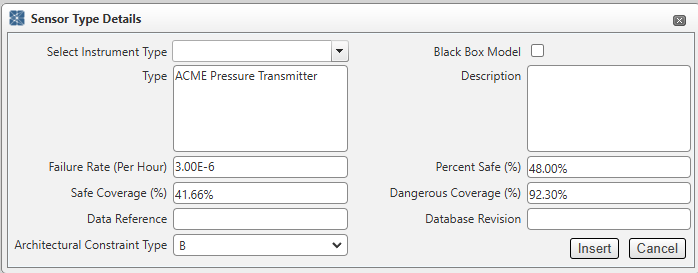It is becoming increasingly common for vendors of industrial control instrumentation to seek SIL Certification in accordance with IEC 61508, particularly when an instrument is intended for use in a safety application. Part of this SIL certification process involves preparation of a Failure Modes, Effects and Diagnostics Analysis (FMEDA) report by a third party certification agency.
The FMEDA study involves understanding of the hardware failure modes of a device and determination of the rates at which a device fails for each of the failure modes identified. It is common for this data to be presented in units of “Failure in Time” abbreviated as “FIT”. In Vertigo™, failure rate data is input in units of failures per hour. The conversion between a “FIT” and “Failures per hour” is as follows.
(1) 1 FIT = 1 * 10-9 failures per hour
In addition, it is common for FMEDA reports to document the rate of each failure mode as Lambdas (Lambda SD, Lambda SU, Lambda DD and Lambda DU). In Vertigo™, these values are calculations based on values entered by the user as safe failure percent, percent safe coverage and percent dangerous coverage.
This article described the method for converting the most common format of failure rate data in an FMEDA into failure rate data fit for entry into Vertigo™. In addition, a simple spreadsheet is attached to automate this conversion.
Let’s assume some sample data from an FMEDA report. It would be common to obtain failure rate date in the following format:
| Device Type | λSD | λSU | λDD | λDU |
| ACME Pressure Transmitter | 500 | 700 | 100 | 1200 |
In the above table, each failure mode is presented in units of FIT’s. I could read the second column of this table as “The safe detected failure rate of an ACME Pressure transmitter is 500 FIT’s”. The first step is to covert these failure rates for FIT’s to failures per hour. We can use the conversion factor above (1) to do this.
λSD = 500 * 1*10-9 = 5 * 10-7 failures per hour
λSU = 700 * 1*10-9 = 7 * 10-7 failures per hour
λDD = 100 * 1*10-9 = 1 * 10-7 failures per hour
λDU = 1200 * 1*10-9 = 1.2 * 10-6 failures per hour
The next step is to calculate the overall failure rate. This is done by simply adding together the failure rates for all four failure modes.
Total Failure Rate = λTotal = 5 * 10-7 + 7 * 10-7 + 1 * 10-7 + 1.2 * 10-6 = 2.5* 10-3 failure per hour
The final step is to calculate the “percent safe failure”, “percent safe coverage” and “percent dangerous coverage”. The following equations are used to complete this calculation.
Total Failure Rate = λTotal = 5 * 10-7 + 7 * 10-7 + 1 * 10-7 + 1.2 * 10-6 = 3* 10-6 failure per hour
Percent safe failure = 100* (λSD + λSU) / λToal = (5*10-7 + 7*10-7) / 3*10-6 = 48 %
Safe coverage percent = 100 * λSD / (λSD + λSU) = 5*10-7 /(5*10-7 + 7*10-7) = 41.66%
Dangerous coverage percent = 100 * λDD / (λDD + λDU) = 1.2*10-6 /(1.2*10-6 + 1*10-7) = 92.3%
The above representation of the failure rate data can now be used directly in Vertigo™ to define failure rates for an instrument type (process connection, sensor type, sensor interface, logic solver type, final element interface or final element type).

